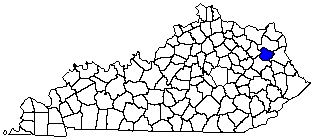



Laurel Gorge, located between Sandy Hook and Newfoundland, is one of the most scenic areas of Eastern Kentucky. A new bridge has recently been constructed at the lower end of the gorge taking KY Rt. 7 and Rt. 32 out of the gorge. The gorge is being transformed into a recreation area.
|
Selection Menu
Elliott Co. Historical Society Old Queries(1996-1997 |
"Elliott county, the 114th in order, was formed in 1869, out of parts of Morgan, Carter, and Lawrence, and named in honor of Judge John M. Elliott. It is situated in the north-eastern part of the state, and bounded N. by Carter, E. by Lawrence, S. by Lawrence and Morgan, and W. by Rowan county. It is surrounded by high hills on three sides, the waters from which shed outwardly into Big Sandy and Licking rivers, but inwardly into Little Sandy river, forming along its tributaries a succession of moderately rich and very pretty valleys.
Martinsburg, formerly Sandy Hook, [Note: the current name for the city is Sandy Hook. cab] the county seat, is 21 miles from Grayson, a railroad point, and 30 miles from Louisa, the head of regular steamboat navigation on the Big Sandy; population in 1870, 62. Newfoundland is 9 miles from Martinsburg and 16 miles from Grayson.
Elliott county, it is generally understood, was named in honor of Judge John M. Elliott, now (Dec. 1873) a resident of Owingsville, Bath county, and circuit judge of the 13th judicial district. Judge E. is a native of Scott co., Virginia; was born May 16, 1820; studied law and was admitted to the bar in 1843; practiced with fine success, at Prestonsburg, Floyd co.; was a representive from Floyd, Pike, and Johnson counties, in the Kentucky legislature, in 1847; a representive in the U. S. congress for six years, 1853-59; again elected representive in the legislature, from Floyd and Johnson counties 1861-63; but an indictment for treason having been found against him, with 31 others (see vol. i, page 97), Nov. 6, 1861, in the U. S. district court at Frankfort, and he (although present from Sept 2 to Oct. 4) not having occupied his seat during the December adjourned session of the legislature, the house, Dec. 21, 1861, expelled him for being "directly or indirectly connected with, and giving 'aid and comfort' to, the Confederate army, repudiating and acting against the government of the United States and the commonwealth of Kentucky." He had thus actively united his fortunes with the cause of the South; was a member of the Provisional Congress of the Confederate States which assembled at Richmond, Feb. 18, 1862, representing the 9th Ky. district; and a member of each successive Regular Congress of the Confederate States; representing the 12th Ky. district, up to the time of the downfall of the Confederacy--over three years in all. In 1868, several years after his return to Kentucky, he was elected, for six years, or until September 1874, circuit judge of the district embracing Bath, Montgomery, Powell, Estill, Owsley, Lee, Wolfe, Morgan, Elliott, and Menifee (10) counties."
|
The elevation in the Elliott County ranges from 645 to 1340 feet above sea level. In 1990 the county population was 6,455 in a land area of 234 square miles, an average of 27.6 people per square mile. The county seat, Sandy Hook, is the only town in the county.

